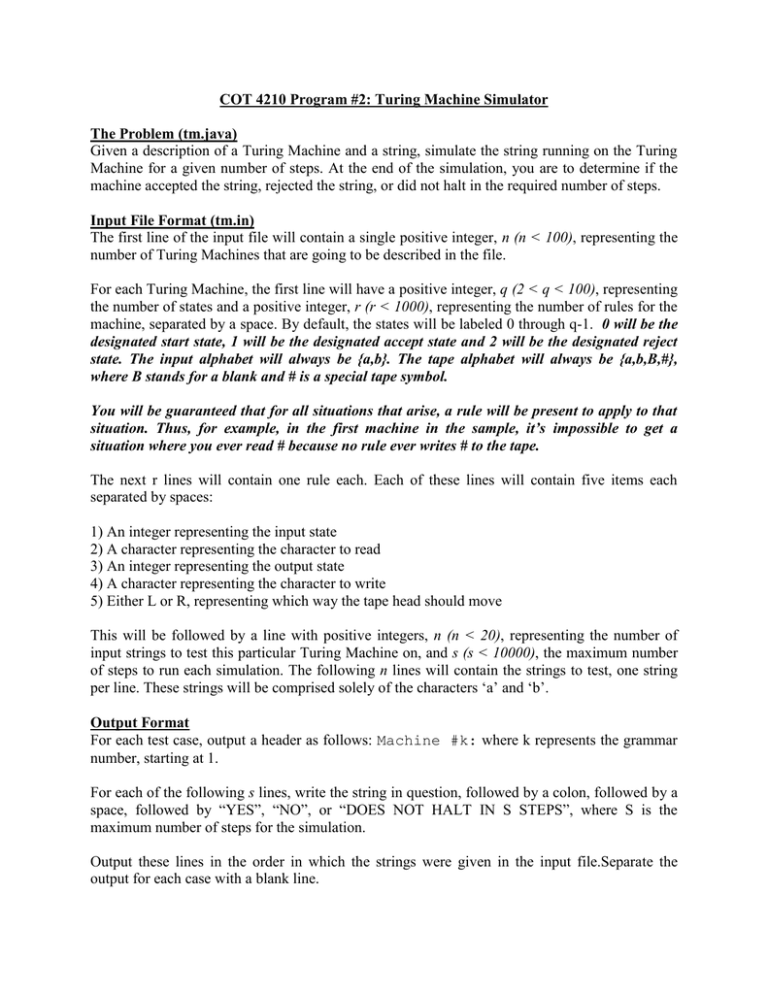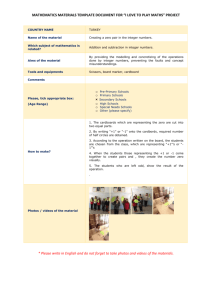COT 4210 Program #2: Turing Machine Simulator The Problem (tm.java)
advertisement

COT 4210 Program #2: Turing Machine Simulator
The Problem (tm.java)
Given a description of a Turing Machine and a string, simulate the string running on the Turing
Machine for a given number of steps. At the end of the simulation, you are to determine if the
machine accepted the string, rejected the string, or did not halt in the required number of steps.
Input File Format (tm.in)
The first line of the input file will contain a single positive integer, n (n < 100), representing the
number of Turing Machines that are going to be described in the file.
For each Turing Machine, the first line will have a positive integer, q (2 < q < 100), representing
the number of states and a positive integer, r (r < 1000), representing the number of rules for the
machine, separated by a space. By default, the states will be labeled 0 through q-1. 0 will be the
designated start state, 1 will be the designated accept state and 2 will be the designated reject
state. The input alphabet will always be {a,b}. The tape alphabet will always be {a,b,B,#},
where B stands for a blank and # is a special tape symbol.
You will be guaranteed that for all situations that arise, a rule will be present to apply to that
situation. Thus, for example, in the first machine in the sample, it’s impossible to get a
situation where you ever read # because no rule ever writes # to the tape.
The next r lines will contain one rule each. Each of these lines will contain five items each
separated by spaces:
1) An integer representing the input state
2) A character representing the character to read
3) An integer representing the output state
4) A character representing the character to write
5) Either L or R, representing which way the tape head should move
This will be followed by a line with positive integers, n (n < 20), representing the number of
input strings to test this particular Turing Machine on, and s (s < 10000), the maximum number
of steps to run each simulation. The following n lines will contain the strings to test, one string
per line. These strings will be comprised solely of the characters ‘a’ and ‘b’.
Output Format
For each test case, output a header as follows: Machine #k: where k represents the grammar
number, starting at 1.
For each of the following s lines, write the string in question, followed by a colon, followed by a
space, followed by “YES”, “NO”, or “DOES NOT HALT IN S STEPS”, where S is the
maximum number of steps for the simulation.
Output these lines in the order in which the strings were given in the input file.Separate the
output for each case with a blank line.
Implementation Restrictions
1) Write your program in Java.
2) Submit tm.java via WebCourses.
Sample Input
2
5 9
0 B 2 B R
0 a 3 a R
0 b 4 b R
3 a 1 a R
3 b 1 b R
3 B 1 B R
4 a 2 a R
4 b 2 b R
4 B 2 B R
3 10
aaab
ba
b
7 15
0 B 2 B R
0 # 2 # R
0 a 3 B R
0 b 2 b R
3 # 3 # R
3 B 1 B R
3 a 4 # R
3 b 2 b R
4 # 4 # R
4 a 5 a R
4 B 6 B L
4 b 2 b R
5 # 5 # R
5 a 4 # R
5 B 2 B R
5 b 2 b R
6 a 6 a L
6 # 6 # L
6 B 3 B R
6 b 2 b R
3 10
a
aa
aaaaaaaa
Sample Output
Machine #1:
aaab: YES
ba: NO
b: NO
Machine #2:
a: YES
aa: YES
aaaaaaaa: DOES NOT HALT IN 10 STEPS

